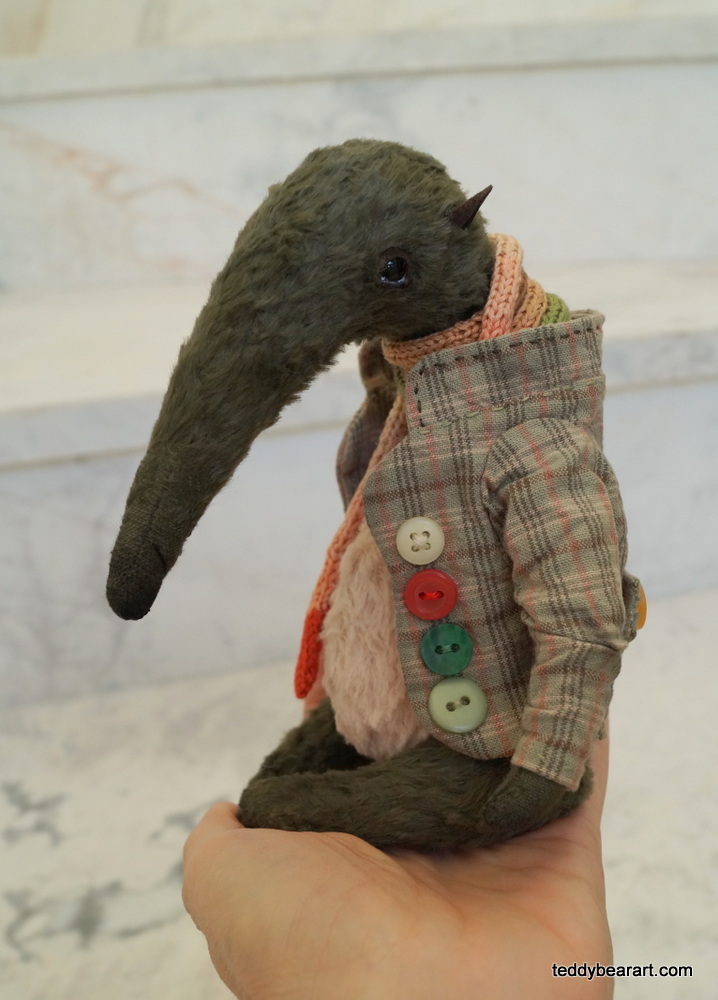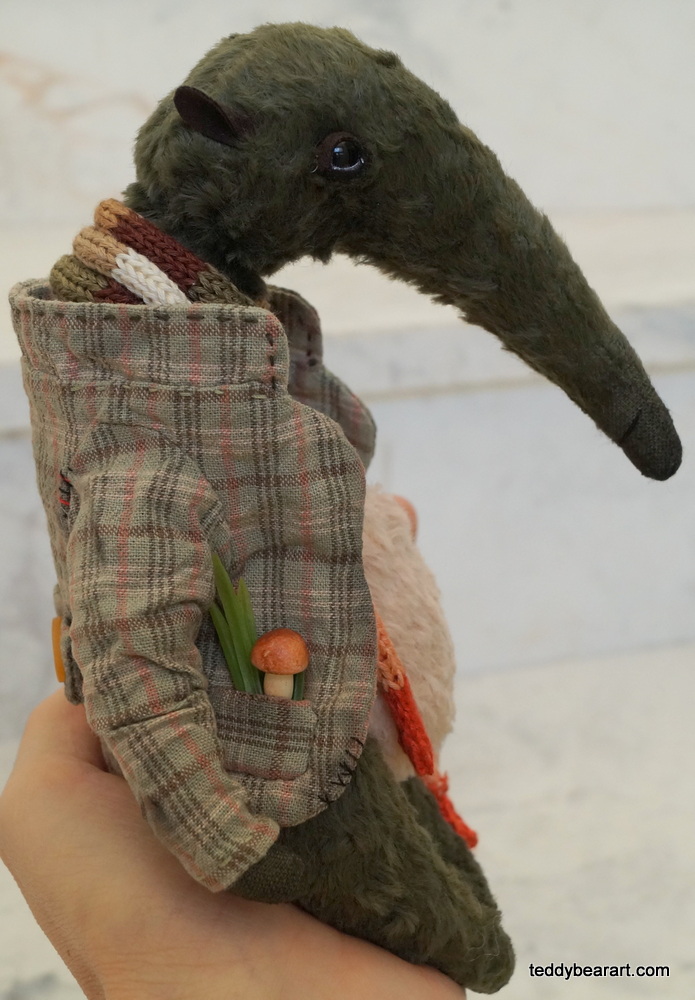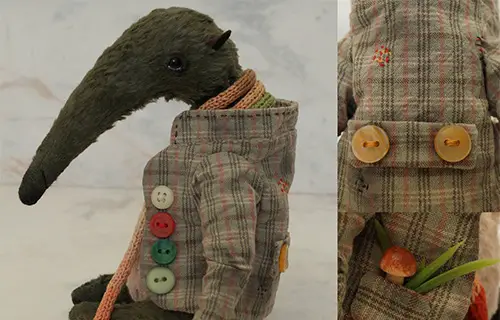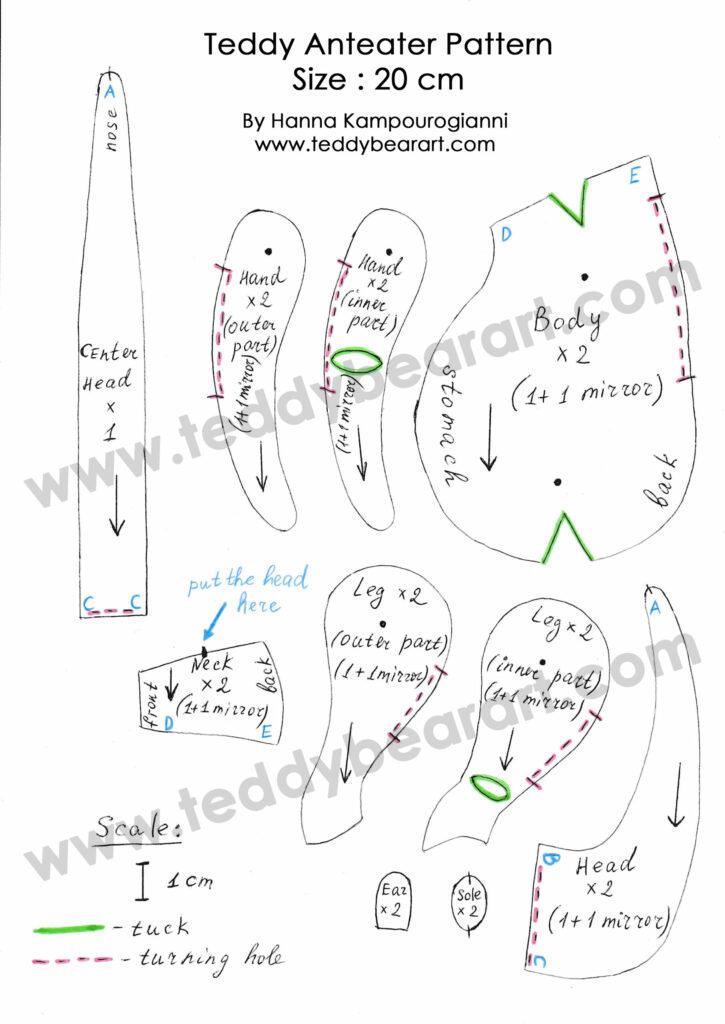*We are a reader-supported website. When you buy through links on our site, we may earn a small affiliate commission at no extra cost to you.*
Introduction
In this article, I am going to share a free teddy bear pattern tutorial “Anteater in a Jacket”, that includes the list of required materials, a step-by-step tutorial for working with the sewing pattern, and guidance for making the teddy anteater. This character was designed by me and became beloved by a lot of collectors from all over the world. Please sew and enjoy!

If you are going to make your first teddy bear I would recommend reading my posts about basic sewing and step by step tutorial “How To Make A Teddy Bear”.
List of Required Materials
This pattern is suitable for short-pile fabric. I sew anteaters from viscose with a pile length of 6 mm and from mohair. I use glass eyes and synthetic filler.
For the ears, you can use leather, suede, felt, or other materials that hold their shape well. For the soles, you can use cotton fabric.
Materials:
1. 1/16 piece (25×35 cm) of viscose with a fur length of 6 mm.
2. Strong threads, the same color as your fabric, and a needle for hand sewing.
3. Scissors for cutting fabrics.
4. A pair of black glass eyes on a metal loop – 6 mm in diameter.
5. Waxed thread.
6. An awl.
7. Synthetic filler.
8. Metal or glass pellets for weight.
9. Fabric for the ears and feet.
10. Oil paints and brushes.
11. Pins.
12. Discs 20 mm diameter – 6 pieces. Discs 15 mm diameter – 4 pieces.
13. Washers 12 mm diameter – 10 pieces.
14. T-shaped cotter pins 1,6×20 – 5 pieces.
15. Pliers.
16. A long needle for attaching the eyes.
The discs for his legs and the head should be 20 mm in diameter. The discs for his hands should be 15 mm in diameter.
Step-By-Step Pattern Tutorial
Printable free teddy anteater pattern you can find here.
When printing a pattern, pay attention to the scale (indicated in the figure).
Arrange the pattern pieces on the fabric so that the direction of the fur matches the arrows.
Leave 5-7 mm for seam allowances.
When I make anteaters from viscose, before I start sewing, I pluck a little lint on the nose, on the sides of the head near the nose, and at the ends of the arms and legs with tweezers.
I do this in order to shape them. It may look sloppy if you decide not to do this but cut the pile already on the finished anteater. Because part of the pile will remain in the seams.
Well, let’s start our work:
Step 1: First of all sew up all the tucks (marked in green).
Step 2: Sew the two sides of the head (1 + 1 mirror) along the marks from A to B.
Step 3: Sew the central part of the head (wedge) with the sides of the head along the marks from A to C. Leave the opening for eversion unsewn (highlighted with a red dotted line).
Step 4: Sew the neck to the body along the marks D to D, and E to E. We do the same with the mirror sides.
Step 5: Sew together the resulting body parts. Leave the opening for the eversion unsewn (highlighted with a red dotted line).
Step 6: Sew the outer and inner parts of the arms (1+1 mirror). Leave the opening for the eversion unsewn (highlighted with a red dotted line).
Step 7: Sew the outer and inner parts of the legs (1 + 1 mirror). Leave the opening for the eversion unsewn (highlighted with a red dotted line).
Step 8: Sew on the feet.
Making Teddy Anteater
Turn out the finished parts of the anteater using a wooden stick with a blunt end.
Stuff the toy’s head tightly with synthetic filler. To do this, use a wooden stick with a blunt end. Be careful not to pierce the fabric.
Insert the disc with a cotter pin into the hole and tighten with waxed thread and needle.
Set the eyes. Use an awl to make holes for the eyes. Pass the waxed thread through the metal loop above the eyelet. Pass both ends of the thread through the eye of a long needle. Use pliers to squeeze the loop lightly.
Do not use force, otherwise, the glass eye may crack. Insert a long needle with thread and an eye into the hole you made with the awl. Bring the needle from the bottom of the head to the cotter pin and secure it.
Do the same with the second eye. Hide all the threads.
If desired, you can glue the eyelids cut out of felt or thin suede.
Sew on the ears.
Insert the head into the body of the anteater (according to the mark on the pattern) and secure the cotter pin.
Insert discs with cotter pins inside of the limb. Fill the limbs with the synthetic filler and sew up the holes.
Connect all the body parts together, then stuff the body. Add some metal or glass pellets for weight and sew up the hole.
Final Touches
Using an awl or needle, remove the pile from all seams and comb the toy with a special metal brush. In the area of the seams, comb in different directions.
Tone the anteater in the area of the nose, eyes, ears, and limbs. Use the colors you like best. These can be pastels, oil paints, fabric paints, and felt-tip pens for fabric. I use oil paints.
Always start tinting with a transition from light to dark tones.
Let your toy dry, and then embroider the mouth with black thread.
Congratulations! Your anteater is ready!
Aging the jacket
The anteater’s jacket pattern you can download here.
Now I will explain to you how you can delicately age this outfit by adding spots. Dilute black acrylic paint with water. Using a brush, spray it on the jacket and dry it immediately with an iron. Of course, practice first on an unnecessary piece of fabric.
In addition, go with dark oil paints along the edges of the jacket, sleeves, and pocket. Just remember that you are not coloring, but only shading the clothes.
Add cute patches. Tie a vintage ribbon or scarf around the anteater’s neck, and add some accessories to your pocket. It can be a flower, a fungus, a key, etc.
The main thing is to keep the scale so that the item is not too large for our character. And voila, the anteater in the jacket is ready!

Conclusion – Feel Free to Sell Your Anteater
So, now you know how to make a teddy anteater and how to sew a jacket for him if you are a beginner. Congratulations! You have your own cute character now.
Feel free to sell anteaters made from this pattern.
If you ever need a hand or have any questions, feel free to leave them in the comments below and I will be more than happy to help you out.
How to download a pattern:
- From a computer (Windows).
Click on the photo of the pattern, and select the “Save image as …” option. - From a phone or a tablet (Android). There should be something similar for the iPad.
Click on the image. Save it by holding your finger on the image and selecting the “Save As” option. Then go to your photo gallery and print it (there is an option).
Join Us for Exclusive Content and Updates!
Are you seeking more inspiration, free patterns, tutorials, and tips for crafting adorable teddy bears? Join our Facebook page for exclusive updates, and don’t forget to subscribe through the Spotlight form towards the beginning of the article—this is your chance to access exclusive content and win teddy bear crafting supplies!
Let’s create together and share the joy of teddy bear art!



Hello..I am not able to access the Anteater coat step by step ..
would you be able to send it to me..kind regards Diana
pippicat53@hotmail.com email
Hello Diana,
Copy this link and search it on Google https://teddybearart.com/free-teddy-bear-sewing-pattern-anteater-in-a-jacket
All the information is there, I have no more. Please read it and follow the instructions below to download the pattern:
From a computer (Windows).
Click on the photo of the pattern you see below. In the new tab that will open, you press the right mouse button and select the “Save image as …” option. Then you choose where you want the image to be saved on your computer.
From a phone or a tablet (Android). There should be something similar for mobile devices with Android or iOS.
Click on the image. Save it by holding your finger on the image and selecting the “Save Image” option. Then go to your photo gallery and print it (there is an option).
Let me know if you manage to get it please.